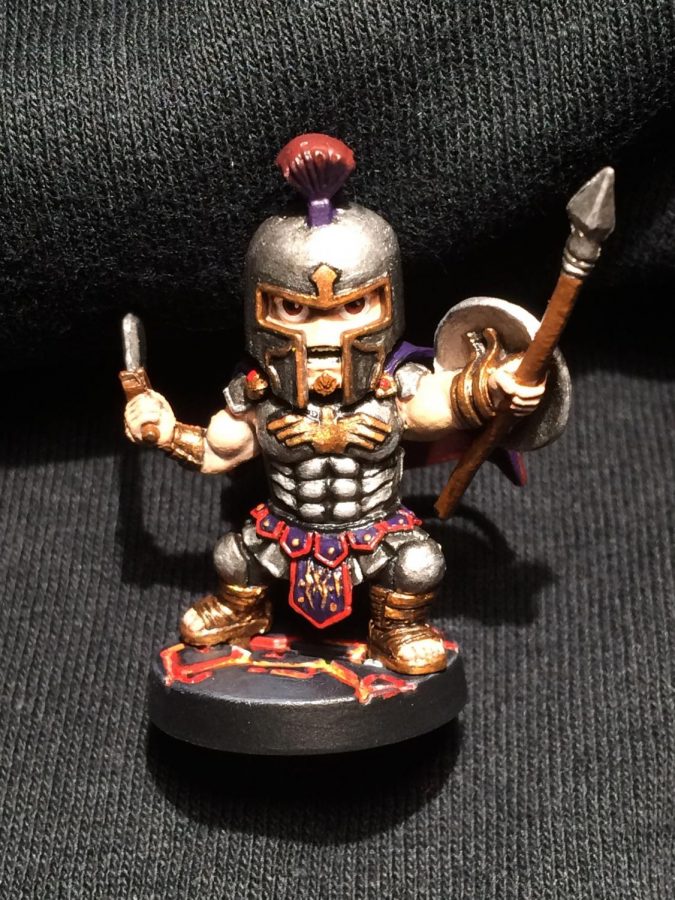Local artist adds color to board games
October 8, 2018
Experienced board gamers and new-comers to the hobby alike, can easily tell that one of the biggest trends in the industry right now is to add lots of elaborately detailed miniature figures to games.
While the miniatures themselves are often striking, many would agree that an element that takes games to another level—aesthetically, is getting the figures painted, an opportunity that attracts both hobbyists and entrepreneurs alike.
We spoke with one local Phoenix board game enthusiast and miniature painter Lauren Buzbee to get a better idea of what it takes to paint miniatures professionally.
Having been painting most of her life Buzbee explained that she became interested in working with miniatures when she was introduced to a particularly special figure.
“A few of our friends started a D&D [Dungeons and Dragons] group, and our Dungeon Master ordered custom 3D printed miniatures for our game. I looked at the clear miniature and decided that I wanted to paint it, and as soon as I finished it, I was hooked,” Buzbee said.
Three years later and Buzbee has continued to hone her craft and even offers her skills on commission.
“Painting is therapeutic for me – I can settle into a project and not look up for hours because I become so enraptured with the process,” Buzbee said. “Painting miniatures is especially rewarding because it’s like breathing life into plastic – something that starts plain and unpainted gains character and vitality through the painting process, and the transition is so fun to create.”
Buzbee admits that her years of painting experience has helped her transition into coloring miniatures for games, but explains that it still holds some unique challenges.
“The toughest part of painting miniatures is the scale, especially of smaller minis. Capturing realism on a very small scale makes every detail incredibly important, one dot or highlight being out of place can change the entire aesthetic of the piece,” Buzbee said.
Despite the difficulties she was quick to offer words of encouragement for anyone thinking of picking up the artform as a hobby or as a means of earning some extra cash.
“Be patient with yourself! Painting is a learning process, and your pieces will likely not look good initially. Don’t give up! Every mini is progress.”
Practically speaking Buzbee also had some important suggestions for newcomers to the trade on how to improve overall quality while keeping materials as cheap as possible.
“Thin your paints to a “milk-like” consistency and layer thin coats or you’ll quickly lose all the detail in your minis,” Buzbee said. “Take good care of your brushes – don’t ever leave them sitting in water, try to keep paint out of the ferrule, and brush soap can make your brushes last nearly forever.”
The paint itself can get kind of pricey, but in this case Buzbee advised against purchasing cheaper paints, and instead focus on limiting the amount.
“Basic acrylic craft paints have comparatively huge pigments in their bottles and do not thin well for miniature coverage. However, you only need a few colors to start – white, black, brown, red, blue, yellow, and a flesh tone can get you quite far if you mix your paints to get your desired hue!”
Eager to offer as much assistance as possible for those interested in painting themselves Buzbee provided advice on acquiring the all-important brushes and, of course, the miniatures themselves.
“Smaller sized, premade miniatures tend to be fairly inexpensive! (try the new WizKids minis) – they come pre-primed, so you can skip the priming step,” Buzbee said. “Next, purchase brushes from art stores with coupons such as Michael’s and Hobby Lobby that stock a good variety of brushes, and almost always have a 40-50 percent off coupon available on their sites, knocking the price down to only a dollar or two per brush.”
While painted figures don’t generally affect the gameplay or mechanics of any given experience, there is certainly something to be said for playing with a figure that has a nice coat of paint—and giving it some “life.”


